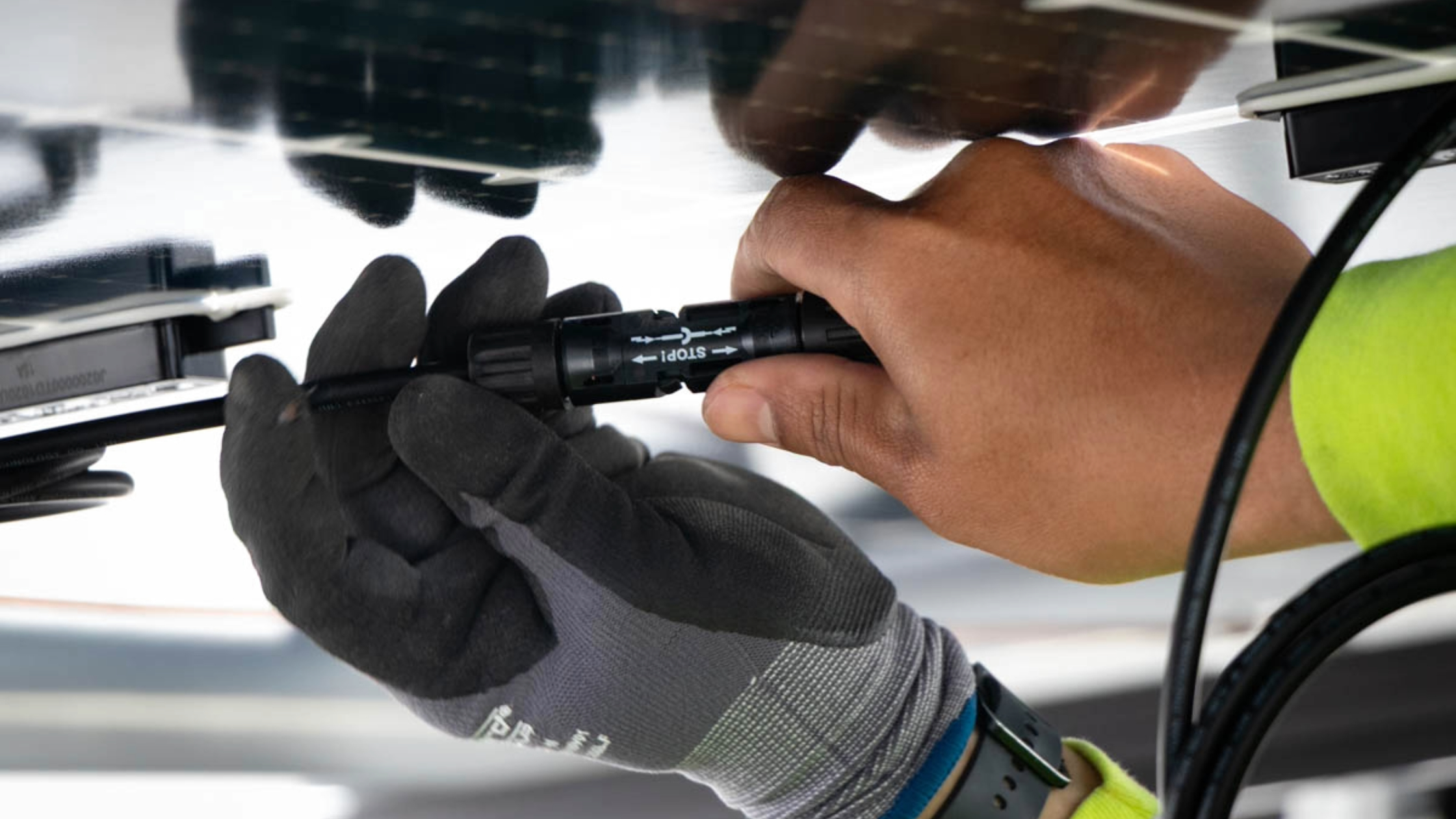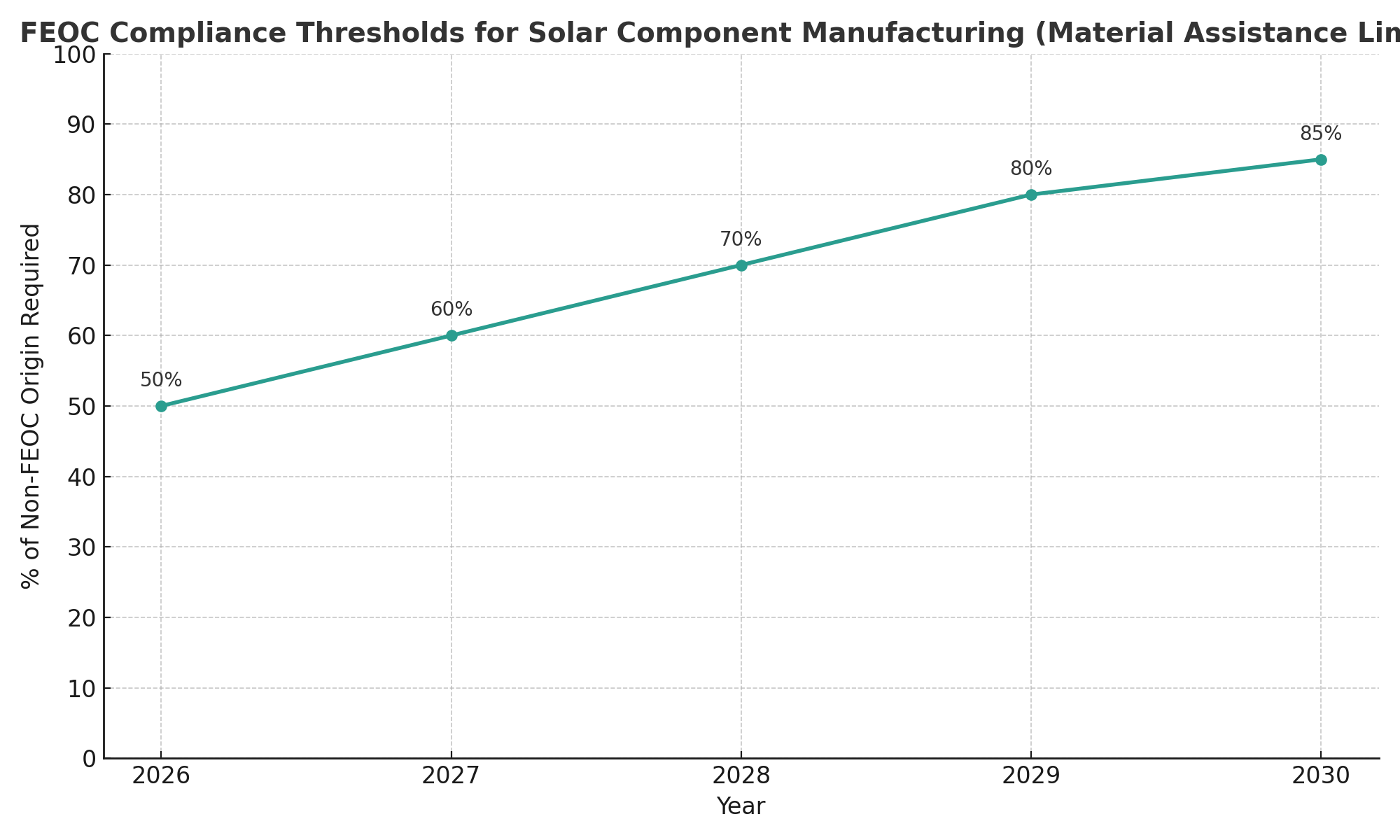What Are Foreign Entities of Concern (FEOC) and How Will They Affect Commercial Solar Projects?

TL;DR: New FEOC rules from the "One Big Beautiful Bill" could eliminate 40-50% of your commercial solar tax credits if you use equipment from Chinese, Russian, Iranian, or North Korean companies. Projects starting construction after December 31, 2025 face the strictest restrictions, with compliance thresholds increasing annually through 2030.
Solar project developers just got hit with a major policy curveball. President Trump signed the "One Big Beautiful Bill" into law on July 4, and buried in this sweeping legislation are some of the strictest foreign entity restrictions we've ever seen for renewable energy tax credits.
If you're planning a commercial solar project, these new rules aren't just regulatory fine print—they could slash your tax credits by 40-50% or eliminate them entirely. Here's what you need to know about Foreign Entities of Concern (FEOC) and why they matter for your bottom line.
What Are Foreign Entities of Concern (FEOC)?
Foreign Entities of Concern (FEOC) are companies that are "owned by, controlled by, or subject to the jurisdiction or direction of a government of a foreign country that is a covered nation." According to the legislation, covered nations are defined as China, Russia, Iran, and North Korea.
How Do FEOC Rules Create Different Categories of Restricted Entities?
The new law doesn't just have one category of restricted entities. It creates a whole hierarchy:
Specified Foreign Entity (SFE): A company with at least 25 percent voting rights, board seats, or equity interests controlled by a covered nation's government.
Foreign-Influenced Entity (FIE): An entity where a covered nation's government has "effective control" through 50% or more of board seats, voting rights, or similar mechanisms.
Prohibited Foreign Entity (PFE): A PFE can be a Specified Foreign Entity (SFE) or a Foreign-Influenced Entity (FIE). These are the entities that face the strictest restrictions.
What Is Material Assistance and Why Does It Matter?
The law also introduces something called "Material Assistance"—basically, any significant capital, technology transfer, or supply-chain support from a FEOC. This is where the rubber meets the road for solar developers.
What Are Prohibited Foreign Entities (PFE) and Why Are They the Strictest Category?
Prohibited Foreign Entities (PFE) are in the penalty box. Under the bill as enacted, eligibility for credits is generally denied if the taxpayer is a PFE or where a PFE is involved in aspects of the facility's development or ownership.
Here's the timeline that really matters: once the rules kick in, there's zero tolerance for Material Assistance from PFEs. For most commercial solar projects, this means if a PFE provides significant equipment, financing, or technical support, you could lose your Investment Tax Credit (ITC) or Production Tax Credit (PTC) entirely.
When Do FEOC Rules Take Effect for Commercial Solar Projects?
The timeline is aggressive, and the thresholds get stricter every year. Here's what you're looking at:
- Immediate Impact (2026): No tax credits can be claimed starting in 2026 by any US taxpayer that is a "specified foreign entity" or a "foreign-influenced entity."
- Projects Starting After December 31, 2025: Cannot receive Material Assistance from a PFE for ITC/48E and PTC/45Y projects.
- Manufacturing Credits (45X): Projects that use components from FEOC-controlled or influenced companies lose access to the tax credit (under 48E) retroactive to June 16, 2025.
What Are the Material Assistance Cost Ratios for Solar Projects?

The "Material Assistance" cost ratios get progressively stricter:
- 2026: At least 50% of your project costs must come from non-FEOC
- 2027: 60% non-FEOC
- 2028: 70% non-FEOC
- 2029: 80% non-FEOC
- 2030 and beyond: 85% non-FEOC
That last number is crucial—by 2030, only 15% of your project costs can come from FEOC-connected suppliers if you want to keep your tax credits.
Why Should Commercial Solar Developers Care About FEOC Rules?
Let's be honest: these rules could fundamentally change your project economics. Here's why you need to act fast:
Your Tax Credits Are at Risk: The ITC can be worth 30-40% of your project cost, and the PTC provides steady cash flow for 10 years. Lose these credits due to FEOC compliance issues, and your project might not pencil out.
The Timeline Is Accelerated: Projects that were under construction by the end of 2024 are largely unaffected by the new law. Projects first starting construction in 2025 must generally comply with the FEOC ownership requirements, but the restrictions tighten quickly.
Supply Chain Disruption: FEOC restrictions are primarily intended to prevent Chinese companies from claiming the tax credits and to reduce reliance on China for supply chains of clean energy technologies. Since Chinese manufacturers dominate solar panel production, compliant alternatives may be scarce or expensive.
Late-Stage Project Impacts: If you're already deep into development, you might need to completely re-spec your equipment package. That means new interconnection studies, updated financial models, and potentially delayed commercial operation dates.
What Should Commercial Solar Developers Do Right Now?
Don't wait for Treasury guidance or hope the rules get softened. Here's what you need to do now:
Map Your Supply Chain: Go through every major supplier—panels, inverters, batteries, racking, even construction contractors. Check if they're connected to FEOC entities at any ownership level. Companies applying for tax credits may need to more definitively detail supply sources and certify compliance with FEOC restrictions under penalty of perjury.
Lock in Compliant Equipment: With everyone scrambling for non-FEOC suppliers, prices are going up and availability is getting tight. If you can find compliant equipment, consider framework agreements or forward purchases.
Stress-Test Your Financials: Run scenarios where you lose some or all tax credits. What happens to your IRR? Your debt capacity? Your offtake agreements? Better to know now than when you're trying to reach commercial operation.
Stay Nimble: The final rules are still being written, and implementation details could change. But don't use that as an excuse to delay—the broad strokes are clear, and the timeline is aggressive.
How Can Green Convergence Help Navigate FEOC Compliance?
We've been tracking these FEOC developments since they first appeared in draft form, and we're already working with our supplier network to identify compliant alternatives. Our team can help you:
- Audit your current vendor relationships against FEOC designations
- Model different compliance scenarios and their impact on project economics
- Navigate the December 31, 2025 construction start deadline to lock in more favorable rules
- Stay current on Treasury guidance and regulatory updates as they emerge
The solar industry has navigated policy changes before, and we'll get through this one too. But success will go to developers who move quickly and plan thoroughly.
How Can You Still Build Profitable Solar Projects Under FEOC Rules?
New FEOC rules will deny technology-neutral tax credits on new power plants and energy storage projects that use too much Chinese equipment and section 45X tax credits on US-made products that use too much foreign content. These aren't hypothetical future restrictions—they're happening now, and they're more aggressive than most people expected.
The good news? If you plan proactively, you can still preserve your tax credits and build profitable projects. The key is understanding that compliance isn't just about avoiding Chinese suppliers—it's about mapping your entire supply chain and ensuring you meet the cost ratio thresholds that get stricter every year.
Not sure how these rules affect your specific project? Let's chat about your plans and map out a compliant path forward. The window for easy fixes is closing fast, but there are still good options if you move quickly.
FEOC Rules FAQ
Q: What countries are considered "covered nations" under FEOC rules?
A: China, Russia, Iran, and North Korea are the four covered nations according to the legislation.
Q: When do FEOC restrictions start affecting commercial solar projects?
A: Projects starting construction after December 31, 2025cannot receive Material Assistance from Prohibited Foreign Entities (PFEs).
Q: What percentage of project costs can come from FEOC sources in 2026?
A: In 2026, at least 50% of your project costs must come from non-FEOC, meaning up to 50% can still come from FEOC-connected suppliers.
Q: Are existing solar projects affected by FEOC rules?
A: Projects that were under construction by the end of 2024 are largely unaffected by the new law.
Q: What happens if my project uses equipment from a Prohibited Foreign Entity?
A: You could lose your Investment Tax Credit(ITC) or Production Tax Credit (PTC) entirely if a PFE provides significant equipment, financing, or technical support.
RELATED ARTICLES:
Our Affiliations









